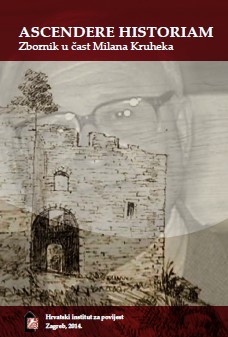Pripadnici plemićke zajednice iz Klokoča na zagrebačkom Gradecu u 15. stoljeću: Primjer uloge sitnoga plemstva u formiranju urbanih elita
Members of the noble community of Klokoč in Zagreb’s Gradec in the 15th century: An example of the role of the lesser nobility in the forming of urban elites
Author(s): Bruno Škreblin
Subject(s): Local History / Microhistory, Social history, Culture and social structure , 15th Century
Published by: Hrvatski institut za povijest
Keywords: Gradec; Klokoč; urban elite; lesser nobility; prosopography;
Summary/Abstract: Among the inhabitants of Gradec, it is quite often possible to identify the members of the lesser nobility who were not only involved in urban life, but they even held various communal functions such were those of city councillors or judges. Although their noble origin is not often emphasised, one can easily argue that they were indeed of the noble origin if they originated from the areas of the today known noble communities such as Klokoč. First newcomers form Klokoč can be attested in the preserved medieval written sources as early as the end of 14th century. In the middle of the 15th century first of the members of the Klokoč community are recorded as office-holders and it is obvious that they became part of the urban social elites. The most famous noble families of the Klokoč community in the medieval Zagreb was the Novak family, family of the Medvedgrad castellan Jacob, son of George, than those of Mathias Farkaš and George Maretić whose son Martin called Vojko is most likely the founder of the well-known noble family of the Vojkovići (Vojkfy). Beside them very notable was also communal juror (iuratus) named Nicholas, son of Damjan, but the most notable was literatus Anthony, son of Thomas, who was on three occasions the communal judge. Prosopographic analysis depicts how all members of the Klokoč community in Gradec were well connected and that they helped each other so it is possible to argue that the members of Klokoč community were the separate social group among Gradec’s urban elite. Even more, by using extant written material, it is possible to reconstruct that the members of the Klokoč community in Gradec had kept the connections with their relatives in Klokoč. At the end, the author argues that within the research of urban elites of medieval Gradec, one has to take in consideration the lesser nobility because the members of Klokoč community were not the only group of lesser nobility who engaged themselves in the urban life of Gradec.
Book: Ascendere historiam: Zbornik u čast Milana Kruheka
- Page Range: 67-80
- Page Count: 14
- Publication Year: 2014
- Language: Croatian
- Content File-PDF

